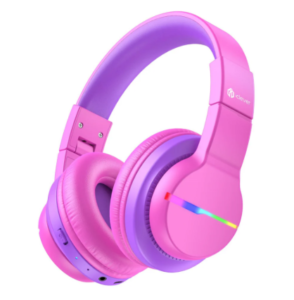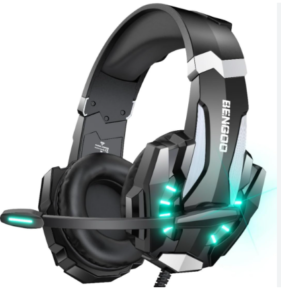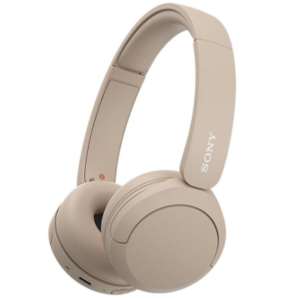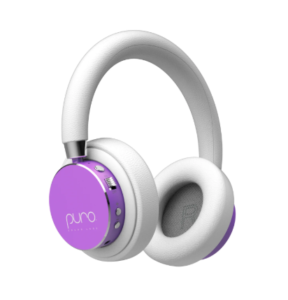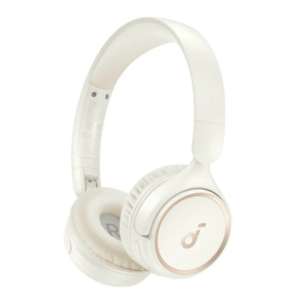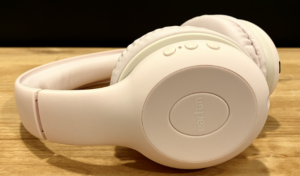While it may be safe for children to use headphones every day, it’s a good idea to manage the amount of time they spend using them.
Of course, it’s a good idea to keep the noise level below 85dB, but it’s also a good idea to limit usage to less than an hour. Wearing headphones for long periods can affect your hearing.
Here are the best kids’ headphones to buy in 2025.
Best Cheap Kids Headphones For School
1. ONANOFF BuddyPhones School+
These great kids’ headphones are made for homeschooling and distance learning, and the BuddyJackCable has a high-quality boom microphone built into it, so you can connect another headset to a single source.
If you don’t need a microphone, a cable without a microphone is also included.
It provides great sound quality for both the wearer and the listener. The child-safe volume limiter (85dB) is very effective, not too loud or too quiet, and it also has effective passive noise cancellation.
The over-ear headphones are comfortable and adjustable, and come with stickers for customization. They come in a variety of colors, including blue, pink, green, and yellow, and a carrying case is included.
The headphones are not wireless, so you may need an adapter for newer phones or tablets that don’t have a headphone jack.
2. iClever BTH12
Like the slightly cheaper BTH12, the iClever BTH12 Kids Wireless Headphones offer great value for money, comfort, and long battery life, with the addition of multi-colored LEDs on the earcups.
The sound quality, handling, and comfort are very similar to the BTH22, but it weighs slightly more at 200g than the BTH22 (160g), and the battery life is 55 hours instead of 60 hours.
In addition to the 74dB and 85dB volume limits, the BTH12 offers a 94dB (“travel”) volume setting.
While I thought 94dB was too loud, I understand that older children may require more volume and that on airplanes or in cars, they may need more volume to block out background noise.
While I prefer to keep the volume to a minimum for hearing protection, if you feel 85dB is too low, there are other options.
If you want to drain the battery a little faster or look your best at a party, you can light up the colorful LEDs on each earpiece. There are four lighting settings. You can turn them off again by pressing the button.
3. PuroBasics
Another successful product from Puro Labs, which offers a variety of models of kids’ headphones, is the PuroBasics, which is a budget version of this premium brand.
The sound quality is good for a budget headphone. The volume is limited (a common complaint), but it’s not nearly as loud as you’d expect, but it’s still pretty loud in my opinion.
They’re comfortable and adjustable and feature a lightweight, flexible plastic frame with soft, vegan leather ear cups.
The PuroBasics are wired (3.5mm jack), so you’ll need an adapter to use them with phones or tablets that don’t have a headphone jack. They come in red, blue, pink, black, purple, and green.
4. BENGOO Gaming Headset
If your child is more into gaming, we recommend the BENGOO Gaming Headset (in fact, we bought three of them for our kids).
The futuristic design of this headset includes a microphone for voice-activated interactive games with friends or for online classes.
These kids’ headphones have LED indicator lights that make the external lighting fun, but they’re only visible to others and require a USB port to work (so they’re not compatible with most tablets or portable gaming devices).
In our testing, these headsets were a hit in online classes and the envy of other kids online.
Overall, we think these headphones are a great choice for kids who want to look cool or spend a lot of time gaming or socializing online during school or social distancing rather than listening to music that’s appealing at high volumes. I got these because the mic was the best, one tester said.
However, if you don’t need a mic or want something lightweight, the Sony ZX series is a great choice for everyday use for kids, and it’ll save you money.
5. Sony CH-520
Sony has a new budget-friendly CH-720N noise-canceling headphone for 2025.
It’s a pretty good product, but if you can’t afford the $150 price tag, Sony’s new budget-friendly on-ear CH-520 headphones are a compelling option for around $50.
They lack noise-canceling and have a no-frills design, but they sound great for the price, are lightweight, relatively comfortable for an on-ear headphone, and have a great battery life (up to 50 hours at moderate volume).
It also supports multipoint Bluetooth pairing, allowing you to pair two devices at the same time, like a smartphone and a computer, and switch audio between them.
Voice call performance is decent but not as good as the CH-720N.
There is no wired option, and these are wireless Bluetooth headphones. The CH-520 offers a balanced sound with decent clarity overall.
The bass is somewhat punchy but not overwhelming, and they don’t offer as wide a soundstage as Sony’s higher-end over-ear headphones.
However, these headphones definitely sound better than Sony’s previous entry-level on-ear headphones and better than I expected. I tried them in white, but they also come in blue and black.
6. Puro Sound BT2200 Plus
While many kids’ headphones look like plastic, the Puro Sound Labs BT2200 headphones look like high-end adult audio gear, and their price reflects that.
They’re a lot better than most of the cheaper headphones listed here. The BT2200 was one of our favorite kids’ headphones, and now, they’ve been upgraded to the BT2200 Plus.
They’re not just stylish and less kid-friendly either. The sound quality of these headphones is noticeably improved, even when using Bluetooth.
If you’re worried about your child pulling too hard on the cable or the cable getting wrapped around their neck, wireless headphones are the way to go.
The volume is capped at 85dB, which is more than enough. The DSP-based volume limiter actively monitors the volume level, and the limiter only kicks in when the sound reaches 85dB.
These headphones don’t just limit the volume. They also block out background noise, attenuating 83% of sound at 1 kHz. So you don’t have to turn up the volume to dangerous levels, even in noisy environments like airplanes.
The Puro Sound Labs BT2200 Plus headphones may be pricier than most kids’ headphones, but their excellent sound quality, solid design, and wireless functionality make them our favorites.
7. Anker H30i Soundcore
The Soundcore H30i is a budget on-ear wireless headphone that competes with the Sony CH-520 and JBL Tube 510BT (successor to the Tune 520BT, due in 2025).
It doesn’t have active noise cancellation, and the headphones themselves aren’t all that great, but they do offer plenty of bass and decent sound quality for the price, and you can pair them to two devices at once via multipoint Bluetooth.
I prefer the Sony CH-520, which is a little more comfortable and sounds a little better (it’s a little clearer).
The H30i has a foldable design, and while it doesn’t have a carrying pouch, it does come with a headphone cord for wired listening (the Sony is wireless only).
The battery life is amazing. The H30i can play for up to 70 hours at moderate volume. Voice call performance isn’t great, but it’s more than adequate in quiet environments.
I also liked that you can adjust the sound profile in the Soundcore app for iOS and Android.
8. EarFun K2 Kids
The EarFun K2 Kids headphones have a slightly more mature design than the other headphones we tested in this category, and their sound quality is also better, thanks to their excellent bass response.
They offer two volume-limiting modes (85dB and 94dB), an over-ear design that passively reduces ambient noise, can last up to 40 hours on a single charge, and use the latest Bluetooth standards. Best of all, they cost less than $30.
For kids who value quality, the K2 Kids headphones offer the AAC codec, which delivers better audio quality than the default streaming quality on Apple devices. Even parents on a tight budget will appreciate the reasonable price tag.
FAQs
Are headphones bad for children’s ears?
Medical experts report that 12.5% of children and adolescents ages 6 to 19 have permanently damaged their hearing by turning up the volume of their earbuds or other devices.
Considering that children spend about 5 hours a day looking at or using screens, the risk of hearing damage is terrifying.
Putting adult headphones on a child’s head can produce loud sounds of 94 to 110 dB, which can be dangerous to hearing.
Children’s headphones with volume-limiting functions are better, but they are not 100% safe for long-term use.
Loud noise can damage the structures, hair cells, and nerve fibers in the inner ear that respond to sound and transmit sound to the brain.
This hearing loss is called noise-induced hearing loss (NIHL), and while it cannot be medically corrected, it is preventable.
Anyone can be damaged by exposure to 110 dB for less than 2 minutes.
Noise damages hearing and causes hearing loss and tinnitus. Long-term exposure or sudden exposure to very loud noise can cause the degeneration of the auditory nerve.
Should children wear in-ear headphones, earbuds, or AirPods?
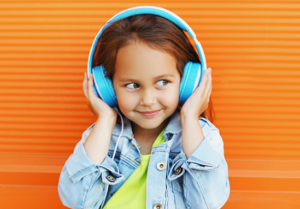
For young children, it is best to avoid earbuds that are inserted into the ear canal, such as ArPods. Earbuds can cause serious harm to the health of your child’s ears.
On-ear or over-ear headphones are a much better choice.
Choose on-ear or over-ear headphones with soft earcups that fit comfortably over your child’s ears and provide both cushioning and protection.
Choosing headphones specifically for children means that they are designed to accommodate the smaller heads of your child.
Look for headphones with soft earcups, especially those made of plush leather. These will provide your child with ample cushioning and protection. Also, choose headphones with an adjustable headband.
Should I choose on-ear or over-ear headphones for my child?
Most headphones for children are compact, on-ear models. On-ear headphones are generally not as comfortable as over-ear headphones (also known as around-ear headphones), but they may be a better fit for younger children with smaller heads. Smaller headphones are also easier to carry around.


